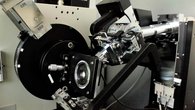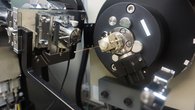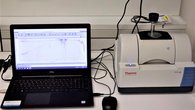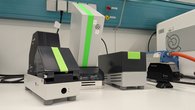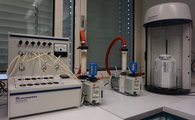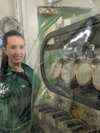Powder X-ray diffractometer STOE StadiP
Location: B360
Our powder X-ray diffractometer (XRD) consists of two individual instruments capable of X-ray scattering analysis using both Cu (λ=1.54 Å) and Ag radiation (λ=0.56 Å) in transmission geometry. XRD can be used to analyze both crystalline and amorphous samples by measuring either conventional diffraction patterns or high Q-range total scattering patterns for pair distribution function (PDF) analysis. Measurements can be performed in room or elevated temperature up to 800 ⁰C.
Cu radiation is more suitable for general structure analysis of crystalline samples. Samples may be analysed in either Debye-Scherrer (capillary) or flat plate geometries. Multi-sample changers are available for both geometries. The Cu-XRD is fitted with a curved Ge (111) monochromator in the incident beam and the scattered X-rays are detected with a DECTRIS MYTHEN2 R 1k photon counting detector.
Ag radiation is more suitable for PDF measurements or materials that are fluorescent in the Cu X-Ray radiation such as Fe-rich materials. Samples may be analyzed in either Debye-Scherrer (capillary) or flat plate geometries. A high temperature furnace is available for samples in Debye-Scherrer geometry. The Ag-XRD is fitted with a curved Ge (111) monochromator in the incident beam and the scattered X-rays are detected with two DECTRIS MYTHEN2 R 1k photon counting detectors.
FTIR spectrometer ThermoFisher Nicolet iS5
Location: C360
The IR spectrometer is used for fast routine IR spectra acquisition in the 4000-400 cm-1 range with a maximum resolution of 0.9 cm-1, although in practice higher resolution than 4 cm-1 is seldom necessary. IR spectra can be measured on both liquid and solid samples. The measurements are usually performed using the diamond attenuated total reflectance (ATR) accessory that allows to obtain a spectra in a few minutes with no sample preparation of very small (<1 mg) sample quantities. Measurements of KBr pellets or similar samples in transmission geometry are also possible. List of accessories available:
- iD7 diamond ATR (most commonly used)
- iD1 transmission
- iD1 in-situ probe with Si ATR tip
- iD Foundation multi-bounce ATR with either ZnSe or Ge prism
UV-Visible spectrophotometer ThermoFisher Evolution 220
Location: C164
The UV-Visible (UV/VIS) spectrophotometer measures absorption of light in 190-1100 nm range. Measurements are possible in either ex-situ mode in cuvettes or in-situ using an external probe. The instrument is mostly used for the determination of elemental concentrations (e.g., Fe2+, As, Si, P) using well-established colorimetric methods. In addition, the spectrophotometer can also be used for the in situ and real-time monitoring of the nucleation, crystallization and growth of minerals, and is equipped with Single Cell Peltier System for temperature control and sample stirring.
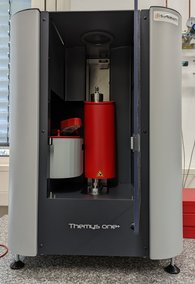
THEMYS ONE+ TG-DTA/DSC Analyzer
Location: C360
The THEMYS ONE+ is a thermal analysis platform with the following features:
- equipped with an auto-sampler with a 32-position carousel
- rods available: TGA rod with built-in S-type thermocouple and DSC rod with P-type thermocouple
- measuring ranges: +/- 1000 mg or +/- 200 mg
- furnace configuration up to 1150°C, with temperature scanning rate from 0.01 to 100 °C/min
- measurements can be done under nitrogen gas, argon, and compressed air
VASCO KIN particle size analyzer
Location: C164
The VASCO KIN is an equipment that uses optical fiber dynamic light scattering (DLS) to characterize submicron particles in liquid dispersions. It can measure particles ranging from 0.5 nm to 10 µm. There are several optical head accessories available that enable measurements in diverse sample set-ups: in situ, in line (milli-fluidic head), in cuvette (thermalized/temperature-controlled head).
Micromeritics Gemini VII gas sorption analyzer
Location: C358
The gas sorption analyzer is used to determine surface area and pore volume of solid materials. Measurements are usually done using nitrogen gas at the boiling point of nitrogen (77 K). The surface area of the material is determined by measuring the amount of gas sorbed onto the surfaces (cm3 N2 STP per g solid) at increasing pressures (adsorption) or decreasing pressures (desorption). The obtained N2 sorption isotherm at varying pressures can be used to distinguish between varying surfaces, outer surfaces, macro-, meso- and microporous surfaces. The BET (Brunauer, Emmett and Teller) theory is commonly used to determine the specific surface area of most solid materials. For porous materials with very narrow micropores (<2 nm), other adsorbent gases need to be used such as argon at 87 K for zeolites and MOFs, and carbon dioxide at 273 K for carbonaceous materials (i.e., activated carbon, nano- and mesoporous carbons).
Related publication:
Figueroa Campos, G. A., Perez, J., Block, I., Sagu, S. T., Saravia Celis, P., Taubert, A., Rawel, H. M. (2021): Preparation of Activated Carbons from Spent Coffee Grounds and Coffee Parchment and Assessment of Their Adsorbent Efficiency. - Processes, 9, 8, 1396. DOI: 10.3390/pr9081396
Krone, L. V., Hampl, F., Schwerdhelm, C., Ganzert, L., Kitte, J. A., Übernickel, K., Dielforder, A., Aldaz Cifuentes, S. R., Oses-Pedraza, R., Perez, J., Sanchez-Alfaro, P., Wagner, D., Weckmann, U., von Blanckenburg, F. (2021): Deep weathering in the semi-arid Coastal Cordillera, Chile. - Scientific Reports, 11, 13057. DOI: 10.1038/s41598-021-90267-7
Hövelmann, J., Stawski, T., Besselink, R., Freeman, H., Dietmann, K. M., Mayanna, S., Pauw, B. R., Benning, L. G. (2019). A template-free and low temperature method for the synthesis of mesoporous magnesium phosphate with uniform pore structure and high surface area. Nanoscale, 11, 14, 6939-6951. DOI: 10.1039/C8NR09205B
Particlemetrix STABINO particle charge mapping
Location: C358
This instrument measures the size and ζ-potential of suspended particles, with an error of 2%. The volume of the measuring cell is 10 mL and the detected size range is between 0.3 nm - 300 μm. The addition of titrants is possible and controlled via two tanks by delivering solutions to the suspension.
Optical Microscopes
Location: A71 - 211
For general sample examination, optical microscopes (potentially with immersion oil) are also available in the Mineral Characterisation Lab. Microscopes available:
- Zeiss Stemi 305
- Zeiss Axio Scope.A1
- Zeiss Axiovert 5
- Zeiss Jenapol
- Leitz LaborLux 11 POL
The microscopes can also be equipped with the following cameras: Sony Alpha 6000 digital camera and Kern ODC-86 microscope camera.
We also have the FlowCam 5000 by Yokogawa, which is a particle analyzer capable of taking optical images. It is comparable to a flow cytometer and features a syringe pump and 100 x 700 µm glass capillary, where liquid passes through. During a sample run, images of the flow are taken with a camera, magnified with a 10x objective. Detected particles are compiled as images in a collage, which can then be grouped and classified by the user based on the particle properties (e.g. size description and morphology, among others) provided by the software. Sample volume ranges from 0.25 to 1 mL.
The FlowCam provides:
- fast data acquisition
- capability to distinguish various particles of the same size and morphology
- large sample volume compared to traditional methods like hemocytometry
- detailed statistics for number and volume of particles in environmental and laboratory samples.
The contact person for the FlowCam 5000 is Sven Peters.



